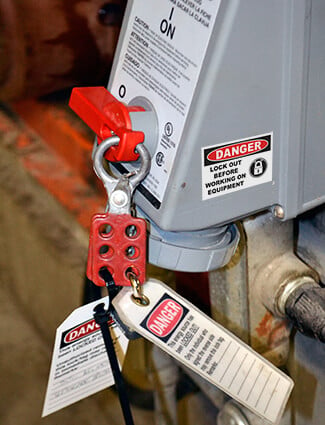Machine Crushing Victim Shares LO/TO Importance
03
February,
2023
3 MINUTE READ

Construction maintenance worker Dan Carey cheated death. "I was crushed, severely injured, and nearly killed in a conveyor accident," he said. After more than 12 surgeries and two years later, his memories of that life-changing day will likely never fade.
On May 25, 2016, with a hard hat and safety glasses on, Carey was making repairs inside an industrial conveyor machine. A belt he was sitting on suddenly began to move. The sudden movement caused him to fall and he was caught in-between moving parts of the machine. The swift pressure from being sucked under a bar eventually broke his left arm, while also shattering five ribs and three vertebrae. Lying in the machine unconscious, Carey was unable to breathe. He said he was preparing to die.
Luckily the worker who had turned on the machine saw Carey inside and was able to get help. Carey spent 16 days in the hospital. Doctors placed a rod and screws in his humerus, the bone that connects the elbow to the shoulder. Skin grafts were applied to areas of his arm and torso that had 3rd-degree burns, which were caused by friction from the belt. Among his other injuries, Carey suffered from a collapsed lung, arm paralysis for four months, and a torn rotator cuff and bicep. He also has post-traumatic stress disorder.
Importance of Lockout Tagout
Whether he lived by the grace of God or the luck of his Irish-American heritage, Carey, 29, said he does not take what happened to him lightly. Posting the details of the work accident on Reddit.com, Carey says he wants to share his story so others can learn from his unfortunate mistake. He owns up to his error, attributing failure to use lockout tagout (LO/TO). He also attributes his injuries to a lack of training for his new co-worker, who was not supposed to turn on the machine Carey was in. "Remember: Safety first and lockout tagout ? it saves your life," he said. "Shortcuts kill. Don't take them. Remember this story the next time you want to avoid safety in favor of production."
Machinery can be powered on at any time and severely injure or kill an unsuspecting worker. The federal Occupational Health and Safety Administration (OSHA) lists LO/TO at No. 5 among its list of top 10 violations. OSHA requires a lockout/tagout program as a way to protect workers from the release of hazardous energy. Machine operators, electricians, and laborers are just a few of the workers among 3 million who service equipment routinely and face the greatest risk of injury, the agency says. In a 2016 Bureau of Safety and Labor report, there were at least 281 deaths caused from workers getting caught-in or crushed by machinery or other equipment. "Employers must ensure that machinery and equipment are de-energized and locked out before workers enter the space to perform operations involving cleaning and servicing," reminds Cal/OSHA Chief Juliann Sum, who responded after several recent LO/TO violations.

Teaching to Prevent
After Carey's latest surgery on Jan. 24, 2018, to repair his shoulder, he has about 70% use of his left arm. Doctors have told him that he likely will not be able to perform physical labor again. Carey said he is considering a career in construction project management and perhaps a future in public speaking.
"Once I get out of this sling, I was invited to speak at my Alma Matter to the incoming heavy equipment program students," he said. "It'll be a great honor and hopefully they'll learn that (injuries) can happen to them too. I pray every day that my story saves someone even a paper cut. ? I've been working around conveyors my entire career in heavy equipment. I knew better."
Rules and regulations, processes and procedures, safeguards, and training all have their place in a facility. Despite all of these systems, risks are still prevalent when working with powered machinery or energized equipment. Managers and workers can pull together to improve risk management and safety performance. Facility workers can learn easily and begin using the components of an excellent LO/TO program that utilize tools such as standardized lockout tags, devices, and multi-lock hasps.
RELATED RESOURCES

Harwood Grant Deadline Soon
Nonprofits have until July 20 to submit applications for a piece of $11.5 million in grant funding from the ...
Read
Biggest OSHA Sign Compliance Challenges
When it comes to signs in the workplace, opinions vary on why they are necessary and if they even work. One ...
Read
4 Signs Your Safety Communication Needs an Update
Safety signs and labels that are up to date, clearly worded, and in tact play a key role in achieving ...
Read.png)


